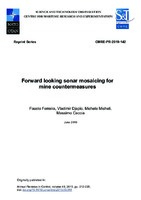| dc.contributor.author | Ferreira, Fausto | |
| dc.contributor.author | Djapic, Vladimir | |
| dc.contributor.author | Micheli, Michele | |
| dc.contributor.author | Caccia, Massimo | |
| dc.date.accessioned | 2019-06-27T16:16:14Z | |
| dc.date.available | 2019-06-27T16:16:14Z | |
| dc.date.issued | 2019/06 | |
| dc.identifier.govdoc | CMRE-PR-2019-142 | en_US |
| dc.identifier.uri | http://hdl.handle.net/20.500.12489/881 | |
| dc.description.abstract | Forward looking sonars (FLS) are nowadays popular for many different applications. In particular, they can be used for Automatic Target Recognition (ATR) in the context of Mine Countermeasures. Currently, ATR techniques are applied to raw data which generates many false positives and the need for human supervision. Mosaicing FLS data increases target contrast and thus reduces false positive rate. Moreover, it implies a considerable data size reduction which is important if one thinks of exchange of data in real time through an acoustic channel with very limited bandwidth. Results of applying a real-time mosaicing algorithm to FLS data generated during Mine Countermeasures missions are shown and discussed thoroughly in this article. | en_US |
| dc.format | 15 p. : ill. ; digital, PDF file | en_US |
| dc.language.iso | en | en_US |
| dc.publisher | CMRE | en_US |
| dc.source | In: Annual Reviews in Control, volume 40, 2015, pp. 212-226, doi: doi.org/10.1016/j.arcontrol.2015.09.014 | en_US |
| dc.subject | Sonar images | en_US |
| dc.subject | Image processing | en_US |
| dc.subject | Automated Target Recognition (ATR) | en_US |
| dc.subject | Target classification | en_US |
| dc.subject | Mine countermeasures (MCM) | en_US |
| dc.subject | Real-time data processing | en_US |
| dc.title | Forward looking sonar mosaicing for mine countermeasures | en_US |
| dc.type | Reprint (PR) | en_US |
| dc.type | Papers and Articles | en_US |
